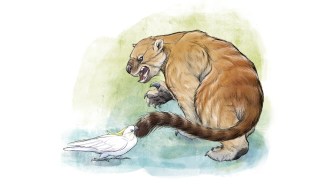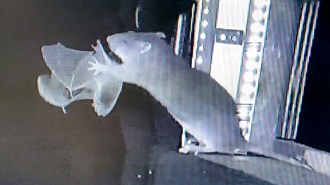New genetic studies of whale meat from Tokyo grocery stores appear to strengthen the case for protecting Antarctica’s minke whales against renewed hunting.

The DNA from minke samples shows such genetic diversity that the Antarctic population must have been extensive for the past 200,000 years, says a Stanford University researcher. That long history challenges the view of some whaling advocates that the 8-meter-long minkes used to be rare in Antarctica but flourished as other whales dwindled. This boom supposedly keeps populations of bigger, competing whales from growing.
“There is no evidence” for such an idea, says geneticist Steve Palumbi, who surveyed the meat of minkes. “They’re not weeds in the Antarctic that need to be culled so other populations can come up.”
As nations jockey to prevent or promote whaling, estimates of how many whales have lived in various locations have raised international debates. Full-scale commercial whaling has been suspended since 1986, when the plunging numbers of many species moved the International Whaling Commission to declare a moratorium.
Several nations, such as Japan, have lobbied for renewing hunts of certain species. And Japan has permitted its fleet to catch some whales—400 Antarctic minkes this season, for example—for research. Scientists have published papers about that catch, but the meat typically ends up in stores. Critics have protested the research and charged that it mostly amounts to an excuse to go on whaling.
Palumbi, however, redirected some of the whale meat in Japan for his own purposes. He and his colleagues analyzed the DNA of grocery meat from 179 Antarctic minke whales. He knew the general geographic source of the whales from permits issued to the Japanese research fleet.
Studying genes from the cell structures called mitochondria, Palumbi’s team has found four to five times as much diversity among the Antarctic whales as in other minke populations the researchers have examined.
To figure out the history of Antarctic minkes, the researchers grouped whales by the degree of genetic similarity and sketched branches on a rough version of a family tree. Other research has worked out the shape of such trees under various scenarios, such as periods of population stability or tumultuous crashes.
The shape of the Antarctic-minke tree indicates “a couple of bumps and troughs” in numbers, but “no real booms and busts,” says Palumbi. For the recent part of its million-year history, the minke whale population has numbered between 500,000 and 1 million, he estimates.
He announced the study results last week in Washington, D.C., at the annual meeting of the American Association for the Advancement of Science.
Another whale researcher at the meeting, Roger Payne of Ocean Alliance in Lincoln, Mass., warned that “people think that whaling is a problem that’s been taken care of, but it’s not.”







